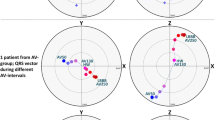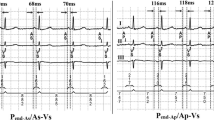Abstract
An optimal electrode position, atrio-ventricular (AV) and interventricular (VV) delay in cardiac resynchronization therapy (CRT) improves its success. An optimization strategy does not yet exist. A computer model of the Visible Man and a patient heart was used to simulate an atrio-ventricular and a left bundle branch block with 0%, 20% and 40% reduction in interventricular conduction velocity, respectively. The minimum error between physiological excitation and pathology/therapy was automatically computed for 12 different electrode positions. AV and VV delay timing was adjusted accordingly. The results show the importance of individually adjusting the electrode position as well as the timing delays to the patient’s anatomy and pathology, which is in accordance with current clinical studies. The presented methods and strategy offer the opportunity to carry out non-invasive, automatic optimization of CRT preoperatively. The model is subject to validation in future clinical studies.





Similar content being viewed by others
References
Abraham WT, Fisher WG, Smith AL et al (2002) Cardiac resynchronization in chronic heart failure. N Engl J Med 346:1845–1853
Albrecht K, Reumann M, Seemann G et al (2005) Computer-aided evaluation and optimisation of biventricular pacing for patients with congestive heart failure. Biomedizinische Technik 50(Supplement):701–702
Auricchio A, Stellbrink C, Block M et al (1999) Effect of pacing chamber and atrioventricular delay on acute systolic function of paced patients with congestive heart failure. The Pacing Therapies for Congestive Heart Failure Study Group. The Guidant Congestive Heart Failure Research Group. Circulation 99(23):2993–3001
Bordachar P, Lafitte S, Reuter S et al (2004) Echocardiographic parameters of ventricular dyssynchrony validation in patients with heart failure using sequential biventricular pacing. J Am Coll Cardiol 44:2157–2165
Bristow MR, Saxon LA, Boehmer J et al. (2004) Comparison of medical therapy, pacing and defibrillation in heart failure (COMPANION) investigators. Cardiac-resynchronization therapy with or without an implantable defibrillator in advanced chronic heart failure. N Engl J Med 250:2140–2150
Cazeau S, Leclerq C, Lavergne T et al (2001) Effects of multisite biventricular pacing in patients with heart failure and intraventricular conduction delay. N Engl J Med 344:873–880
Cleland JGF, Daubert JC, Erdmann E et al (2005) The effect of cardiac resynchronization on morbidity and mortality in heart failure. N Engl J Med 352:1539–1549
Dössel O, Farina D, Mohr M, Reumann M, Seemann G, Weiss DL (2006) Computer-assisted planning of cardiac interventions and heart surgery. In: Informatik 2006, Informatik für Menschen, pp. 499–506. Gesellschaft für Informatik e.V. (GI), Köllen Druck+Verlag GmbH, Bonn
Farina D, Dössel O (2006) Influence of cardiac activity in midmyocardial cells on resulting ECG: simulation study. In: Proceedings Biomedizinische Technik ISSN 0939–4990
Higgins SL, Hummel JD, Niazi IK et al (2003) Cardiac resynchronization therapy for the treatment of heart failure in patients with intraventricular conduction delay and malignant ventricular tachyarrhythmias. J Am Coll Cardiol 42(8):1454–1459
Kass DA, Chen CH, Curry C et al (1999) Improved left ventricular mechanics from acute VDD pacing in patients with dilated cardiomyopathy and ventricular conduction delay. Circulation 99(12):1567–1573
Kerckhoffs RC, Neal ML, Gu Q et al (2007) Coupling of a 3D finite element model of cardiac ventricular mechanics to lumped systems models of the systemic and pulmonic circulation. Ann Biomed Eng 35(1):1–18
McAlister FA, Ezekowitz JA, Wiebe N et al (2004) Systematic review: cardiac resynchronization in patients with symptomatic heart failure. Ann Intern Med 141(5):381–390
Miske G, Acevedo C, Goodlive TW, Brown CM, Levine TB (2005) Cardiac resynchronization therapy and tools to identify responders. Congest Heart Fail 11(4):199–206
Nelder JA, Mead R (1965) A simplex method for function minimization. Comput J 7:308–313
Perego GB, Chianca R, Facchini M et al (2003) Simultaneous vs. sequential biventricular pacing in dilated cardiomyopathy: an acute hemodynamic study. Eur J Heart Fail 5(3):305–313
Porciani MC, Dondina C, Macioce R et al (2005) Echocardiographic examination of atrioventricular and interventricular delay optimization in cardiac resynchronization therapy. Am J Cardiol 95:1108–1110
Press WH, Teukolsky SA, Vetterling WT, Flannery BP (2002) Numerical Recipes in C. The art of scientific computing, 2nd edn. Cambridge University Press, Cambridge
Reumann M, Bohnert J, Osswald B, Hagl S, Dössel O (2007a) Multiple wavelets, rotors and snakes in atrial fibrillation - a computer simulation study. J Electrocardiol (in press) Epub March 2nd 2007 doi:10.1016/j.jelectrocard.2006.12.016
Reumann M, Osswald B, Dössel O (2007b) Non-invasive, automatic optimization strategy in cardiac resynchronization therapy. Anatol J Electrocardiol (7 suppl) 1:209–212
Sermesant M, Delingette H, Ayache N (2006) An electromechanical model of the heart for image analysis and simulation. IEEE Trans Med Imaging 25(5):612–625
Sogaard P, Egeblad H, Pedersen AK et al (2002) Sequential versus simultaneous biventricular resynchronization for severe heart failure: evaluation by tissue doppler imaging. Circulation 106(16):2078–2084
Streeter DD (1979) Gross morphology and fiber geometry of the heart. Handbook of Phsiology: the cardiovascular system (B. Bethseda, ed.). Am Physiol Soc 1:61–112
Ten Tusscher KHWJ, Noble D,Noble PJ, Panfilov AV (2004) A model for human ventricular tissue. Am J Physiol Heart Circ Physiol 286(4):H1573–H1589
Van Campen CMC, Visser FC, de Cock CC, Vos HS, Kamp O, Visser CA (2006) Comparison of the hemodynamics of different pacing sites in patients undergoing ressynchronization therapy: need for individualization an optimal lead localization. Heart 92(12):1795–1800
Van Gelder BM, Bracke FA, Meijer A, Lakerveld AJ, Pijls NH (2004) Effect of optimizing the VV interval on left ventricular contractility in cardiac resynchronisation therapy. Am J Cardiol 93:1500–1503
Verbeek XAAM, Vernooy K, Peschar M, Cornelussen RNM, Prinzen FW (2003) Intra-ventricular resynchronyzation for optimal left ventricular function during pacing in experimental left bundle branch block. J Am Coll Cardiol 42:558–567
Whinnett ZI, Davies JER, Willson K et al (2006) Haemodynamic effects of changes in atrioventricular and interventricular delay in cardiac resynchronisation therapy show a consistent pattern: analysis of shape, magnitude and relative importance of atrioventricular and interventricular delay. Heart 92(11):1628–1634
Young JB, Abraham WT, Smith AL (2003) Combined cardiac resynchronization and implantable cardioversion defibrillation in advanced chronic heart failure: the MIRACLE ICD trial. JAMA 289:2685–2694
Acknowledgment
The authors would like to acknowledge the data acquisition of the patient data set by the University of Würzburg, which was carried out in a research project funded by the German Research Foundation DFG (No. DO 637/6-1).
Author information
Authors and Affiliations
Corresponding author
Rights and permissions
About this article
Cite this article
Reumann, M., Farina, D., Miri, R. et al. Computer model for the optimization of AV and VV delay in cardiac resynchronization therapy. Med Bio Eng Comput 45, 845–854 (2007). https://doi.org/10.1007/s11517-007-0230-x
Received:
Accepted:
Published:
Issue Date:
DOI: https://doi.org/10.1007/s11517-007-0230-x




